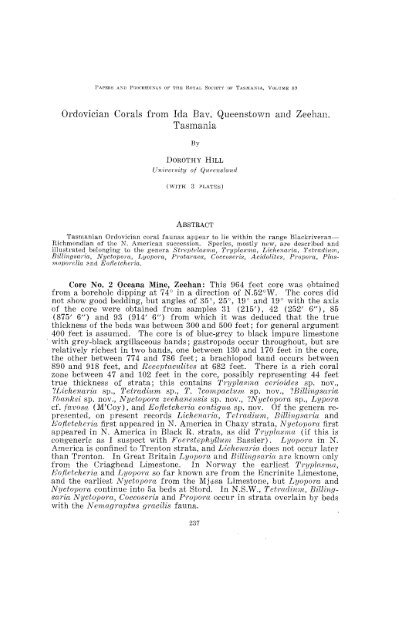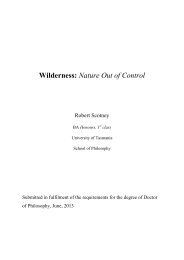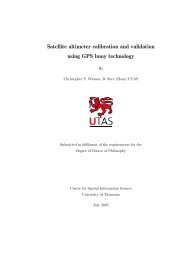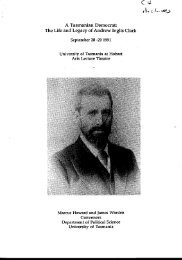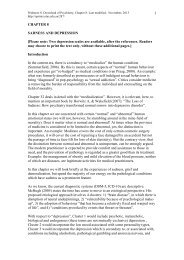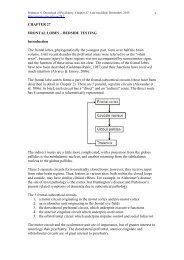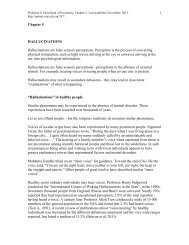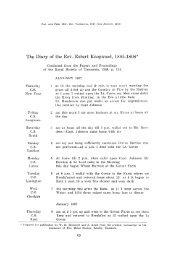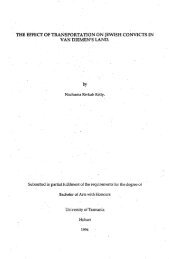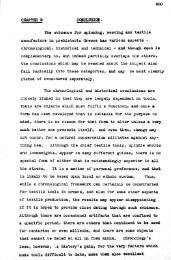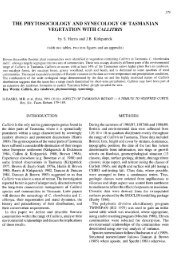Ordovician Corals from Bav, Queenstown Tasmania - UTas ePrints ...
Ordovician Corals from Bav, Queenstown Tasmania - UTas ePrints ...
Ordovician Corals from Bav, Queenstown Tasmania - UTas ePrints ...
Create successful ePaper yourself
Turn your PDF publications into a flip-book with our unique Google optimized e-Paper software.
<strong>Ordovician</strong> <strong>Corals</strong> <strong>from</strong> <strong>Bav</strong>, <strong>Queenstown</strong><br />
<strong>Tasmania</strong><br />
<strong>Tasmania</strong>n <strong>Ordovician</strong> coral faunas<br />
Richmondian of the N. American<br />
illush'ated belonging to tbe genera<br />
Billings(uia, NZ/ctopoi'a,<br />
mopm'clla :?,nd Eo/letchcl'ia.<br />
By<br />
DOROTHY HILL<br />
IIft'i1Jer8itZ/ 0/ Queensland<br />
(WITH PLATES)<br />
ABSTRACT<br />
to lie within the range Blaekriveran--<br />
Speeies, mostly described and<br />
'l'etradium,<br />
Pla8-<br />
Core No.2 Oceana Mine, Zeehan: This 964 feet core 'Nas obtained<br />
<strong>from</strong> a borehole dipping at 74° in a direction of N.52°W. The cores did<br />
not show good bedding, but of 35°,25°, 19° and 19') with the axis<br />
of the core were obtained <strong>from</strong> samples 31 42 6"), 85<br />
(875' 6/f) and 93 6") <strong>from</strong> which it was the true<br />
thickness of the beds was between 300 and 500 feet; for argument<br />
400 feet is assumed. The core is of blue-grey to black limestone<br />
with grey-black argillaceous bands; gastropods occur throughout, but are<br />
relatively richest in two bands, one between 130 and 170 feet in the core,<br />
the other between 774 and 786 feet; a brachiopod band occur" between<br />
890 and 918 feet, and Receptaculites at 682 feet. There is a rich coral<br />
zone between 47 and 102 feet in the core, possibly representing 4,1 feet<br />
true thickness of strata; this eontains Tr'lJplaw)(w cerioides<br />
'!1.Achenaria sp., Tetradiurn T.<br />
?banlcsi 8p. nov.,<br />
cL (M'Coy),<br />
237
240 ORDovrcJAN CORALS<br />
SYSTEMATIC DESCRIP1'IONS<br />
\iVhere ordinal, family, or generic diagnoses are not given<br />
the reader should consult Hill, D, " The <strong>Ordovician</strong> <strong>Corals</strong>". P1'oc.<br />
Roy. Soc. Qlcl., LXII, pp. 1-·27. Where of genera are not<br />
should be made to S. and Thomas, H.<br />
Index of Palaeozoic Coml l'vluseum<br />
pp. i-vii, 1-231.<br />
Order: IrUGOSA Edwards and<br />
Sub-order: Streptelasmatina<br />
Family; STREPTELAHMATIDAE Nicholson, 1889 (as Streptoiasmidae)<br />
Genus: Strepteltumux Hall, 1847<br />
Sti"Cpie!rMl1n.a sp. d. (M'Coy) (.PI. III, fig. 35)<br />
* M:UG D2126 <strong>from</strong> Ida Bay is a of a solitary with<br />
patches of recrystallisation' a diameter of 18 mm. there<br />
are at least 35 major and 35 minor so dilated as to be contiguous<br />
in the minor septal zone about 3 mm. ; the thick septa extend<br />
unequaBy into the tabularium, most but a little way, some few a considerable<br />
way, some running together in of two or and<br />
with thickened paliform lobes axially.<br />
ends is elearly seen, but is<br />
(M'Coy, 1850; 1851, p. 39, pI.<br />
stone of England, which is either of<br />
the zone of Dicellograptw; (tnceps.<br />
M'Coy (Sedgwick Museum<br />
Limestones of Wales, which is<br />
peltifer zone, though probably of either<br />
zone.<br />
Sub-order: CystiphyUina 1889<br />
Family: TRYPLASMATIDAE Etheridge, 1907 (as Tl'yplasmidae)<br />
Genus: T'r-yplasma Lonsdale, 1845<br />
TnJpl(1Sn1a cerioidcs sp. nov. (PI. I, figs. la, b, PI. III, fig, 36)<br />
Hoiotype; MUGD2123, Ida <strong>Tasmania</strong>.<br />
Diagnosis: Cel'ioid or partly<br />
erease; corallites up to 9 mm. in<br />
subequal<br />
: The coral1um is cerioid in<br />
arise inside the<br />
variation in size of<br />
and 9 nUL in diagonal diameters. There<br />
zone about 0,25 mm, within which the<br />
each js a vertical<br />
of each is<br />
vertical series and extending almost inwards<br />
observed dh;tance of 1 mm. In a eorallite of 8 mm.<br />
Hre 38 which are not divisible into alternate<br />
shorter and minor) of<br />
are opposite or sub-opposite,<br />
are complete and moderately<br />
for a maxiI"num<br />
diameter there<br />
of and
OHDOVICIAN CORALS<br />
l,1amily: SYRINGOPHYLLIDAE. Pacta, 1902<br />
=Lyoporidae Kiaer, 1930; Calapoeciidae Hill, 1951.<br />
Massive; septa short, thick, spinose and typically equal in number in<br />
any species; mural pores interseptal and arranged in horizontal rows,<br />
each row just above a tabula; coenenchyme may be formed by extensions<br />
<strong>from</strong> the tabulae and septa which intersect to enclose horizontal tubular<br />
tipaces. M.Ord.- L. SiL<br />
Sub-family: Billingsariinae Hill, 1951 (= emend. Billingsaridae Okulitch, 1!J86)<br />
=Nyctoporinae Hill, 1951<br />
Coenenchyme absent or of vertical trabeculae only, septa short,<br />
typically 16, may alternate in size. lVI.-U.Ord.<br />
Genus·: Billingsaria Okulitch, 1986<br />
Type species by original designation Columnar'ia parva Billings, 1859.<br />
Septal trabeculae dilated wedgewise to form a thick wall; vertical<br />
ttabeculae may develop at axis. M.Ord., N.Am., Aus.<br />
I have considerable doubt whether the separation of this genus <strong>from</strong><br />
Nyctopom is justifiable.<br />
Billingswria banksi sp. nov. (PI. III, fig. 40).<br />
Holotype: MUGD 2113 <strong>from</strong> Ida Bay, S.E. <strong>Tasmania</strong>.<br />
Diagnosis: BUlingsar1:a with corallites 3 in 3 mm.<br />
Description: CoraIlum hemispherical. There are B calices in 3 mm.<br />
Each corallite possesses 8 septa each about * of the radius of the corallite,<br />
and dilated wedgewise towards the periphery; most corallites also show 8<br />
much shorter septa, alternating with the longer; the septal trabeculae<br />
are clearly visible in transverse section, one in each short septum, two or<br />
more in each longer septum and they are apparently almost vertical.<br />
Some corallites show a strong columella, consisting apparently of a single<br />
trabecula, others several disjunct trabeculae, and many, no axial structure.<br />
Tabulae are thin and rather distant.<br />
Remarks: A very small specimen UT 23532 (PI. 1, fig. 2) <strong>from</strong> sample<br />
3 (47 to 48') in Core No.2 Oceana, Zeehan, Smelter's Limestone, encrusting<br />
a polyzoan, is referred somewhat doubtfully to this species, owing to<br />
the habit and smaller size of comllite (4 in 3 mm.) .<br />
This <strong>Tasmania</strong>n species is very similar to the N. American Chazy<br />
type species and to the Scottish Craighead (,!=rrrenton) B. occ'irZentali8<br />
(Nich. & Eth.). The trabeculae are not tightly welded together and in<br />
thin sections where recrystalli'Sation has occurred the spaces between them<br />
appear falsely as canals (cf. Okulitch, 1986, p. 61).<br />
Genus Nycto}Joyn Nicholson, 1879<br />
Type species N. billing8i Nicholson, 1879, which was a nom. no'v. for<br />
Columnaria golrZfussi Nicholson 1875 (non Billings, 1858 <strong>from</strong> the Trenton<br />
of Peterborough, Canada.
DJR0THY HILL 247<br />
Walls and septa relatively thin. JVl.-U.Ord.<br />
Nicholson's figures of the type species (1879, pI. 9, figs. 3a-c) show a<br />
moderately thin and rather crenulate wall with mural pores and without<br />
regularity of septal arrangement. A thin section of a specimen in the<br />
British Museum <strong>from</strong> Nepean Pt., Ottawa, referred to N. bilUngs?:, shows<br />
a horizontal row of small pores in the walls as in Bassler<br />
(1950, p. 267) has founded SaffoYdophyll:um on a species in which there<br />
are 8 septa only and these proceed <strong>from</strong> inwardly directed undulations<br />
in the thin wall; Nicholson's figure of N. billingsi however, suggeRts that<br />
it also has undulate though somewhat thicker walls. rrhose species with<br />
12 septa placed by Bassler in S(tfJOTdophyllum and in Nyctopora (PToheliolites)<br />
should, it seems to me, be transferred to the family Heliolitidae,<br />
genus Proheliolites.<br />
Nyctopora zeehanenBis, sp. nov. (PI. I, figs. 3a, b)<br />
Holotype: UT 23531 <strong>from</strong> sample 11 at 91 feet in Core No.2 Oceana<br />
Mine, Zeehan, in Smelter's Limestone.<br />
Diagnosis: Corallum massive with corallites 1'25 mm. in diameter with<br />
rather thin, crenulate walls; septa unequally developed <strong>from</strong> corallite to<br />
corallite but in parts of some eight longer alternate with eight shorter,<br />
each rising <strong>from</strong> an inwardly projecting crenulation.<br />
Description: The cor'allum is large and cerioid, with corallites 1'25<br />
mm. in average adult diameter and five or six-sided. The common walls<br />
are moderately thin with vertical waves; septa project <strong>from</strong> the inwardly<br />
projecting crests; septal development is imperfect, or unequal <strong>from</strong> corallite<br />
to corallite; the maximum development would appear to be 16, 8 longer<br />
and 8 shorter, but sections of few corallites show this perfectly; some show<br />
no septa; others show a few longer septa with perhaps a few shorter<br />
alternating; the waves in the wall are likewise not regularly or equally<br />
developed. The septa appear trabeculate. No mural pores have been<br />
observed, and tht:C) tabulae are thin, almost horizontal and rather close.<br />
Remarks: Eixcept for the absence of mural pores, this species 1'8sembles<br />
very closely the thin sections of the syntype of the type species<br />
figured by Nicholson (1879, pI. 9, figs. 3a-c) <strong>from</strong> the Trenton of Peterborough,<br />
Canada.<br />
Nycto]Jora sp. (PI. II, fig. 80)<br />
One small domed fragment <strong>from</strong> Loc. 15, near H.E.C. Tower, 287,<br />
Bubb's Hill, Victoria Pass, Lyell Highway, <strong>Tasmania</strong> has corallites 1 mm.<br />
in average diameter, with 8 very short major and 8 minor septa each of<br />
vertical trabeculae, and rather distant fiat tabulae. The occurrence of<br />
this typieally <strong>Ordovician</strong> genus sufficiently determines the age of the<br />
Bubb's HiB fauna as Middle or Upper <strong>Ordovician</strong> though the material is<br />
insufficient for detailed description.<br />
?Nyctopom sp. (PI. I, fig. 4)<br />
Material: One fragment UT 2:3530 <strong>from</strong> sample 14 (9"1 feet 6 inches<br />
to 95 feet), <strong>from</strong> Core No.2, Oceana Mine, Zeehan.<br />
Description: The corallum, known only <strong>from</strong> a fragment intersected<br />
in a bore core is either ramose or tumulose, since in a vertical section the<br />
corallites curve outwards <strong>from</strong> an axial region to open somewhat obliquely
248 ORDOVICIAN COHALS<br />
at the calices, opposite ealical faees on the branch<br />
15 mm. distant. The coralliies are<br />
the average adult diameter being 1 mm.<br />
uncertain whether the common walls are thick or<br />
the transverse section of the corallum one<br />
tinguishable in the almost like<br />
others, outgrowths <strong>from</strong> the walls to be<br />
in colour but not so dark as the wall tissue.<br />
or tall tumulus being<br />
five or six-sided,<br />
leaves one<br />
not· in some parts of<br />
trabeculae dis-<br />
I am uncertain whether or Lichenaria is the correet<br />
reference, but I ineline to view that trabeculae are present<br />
as in the Billingsariinae and therefore the fragment doubtfully in<br />
Nyctopora. No mural pores are present either of the sections prepared.<br />
In vertical section, the walls appear a little thickened, and many of the<br />
tabulae show a sudden axial up arching.<br />
Sub-family: Syringophyllinae.<br />
=Calapoeciinae Hill, 1951.<br />
Cerioid or with coenenchyme; septa 20 to 24, equal. l\LOrd.-Sil.<br />
Genus: Lyopora Nieholson & Etheridge, 1878<br />
=IAopora Lang, Smith & Thomas, 1940, non Girty, 1915.<br />
Type species: Palaeopora? favosa M'Coy, 1850, p. 285, described and<br />
figured as Palaeopora favosa M'Coy, 1851, p. 15, pI. IC, fig. c, 3a-d, <strong>from</strong><br />
the <strong>Ordovician</strong> limestone and shale of Craighead, Girvan, Ayrshire, Scotland.<br />
The Middle <strong>Ordovician</strong> Craighead Limestone is possibly of the<br />
CUmacograptu8 peltifer zone.<br />
Massive coralla with polygonal corallites in which each corallite has<br />
a single peripheral ring of ?20 vertical series of slightly inclined thick<br />
trabeculae, those of neighbouring corallites alternating or opposed; the<br />
thick double walls so formed may he pierced in horizontal zones by a row<br />
of irregular rounded pores, each caused by a local thinning of the<br />
trabeculae; the tabulae are distant and slightly sagging.<br />
The genus is known <strong>from</strong> the Clirnacograptus lJeltife1' zone in Scotland<br />
(Craighead) and Kalstad, Mjsa and EncI'inite Limestones (4f:J) in Norway<br />
and the Trenton (Jacksonburg Limestone) of New York, U.S.A.<br />
The known range is thus between the C. peltijer and D'icranograptus<br />
clingani zones inclusive.<br />
Lyopora cf. favosa (M'Coy) (PI. I, fig. 5)<br />
Material: One fragment UT 23537 in sample 6 (58 feet to 58 feet<br />
6 inches) in Core No.2, Oceana Mine, Zeehan, <strong>Tasmania</strong>, Smelter's Limestone.<br />
This small fragment differs in no essential particular <strong>from</strong> the type<br />
species especially as it is developed in Norway; the common walls be,"<br />
tween corallites are on the average 1 mm. thick, the free space in the<br />
corallite 1·3 mm. wide, thtrs slightly smaller than in the Norwegian and<br />
Scottish examples. The trabeculate septa are distinguishable, in transverse<br />
section, but no information on inclination of the trabeculae is available<br />
<strong>from</strong> the vertical section owing to recrystallisa tion. Vacuities in the<br />
wall are in somewhat irregular horizontal rows. The tabulae are thin,<br />
sagging and distant. Detailed description of the Scottish (Cox, 1936)<br />
and Norwegian (Hill, 1953) specimens should be consulted.
DOROTHY HILL 231<br />
Family; AULOPORIDAE Edwards and Haime, 1850<br />
:c:=Syringoporiens de Fromeniel, 1864; Syringoporidae Hill, 1951.<br />
Genus: A.ulopora Goldfuss', 1829<br />
Type species (designated by Edwards and Hahne, 1850, pl. xxvi)<br />
A, seTpens Goldfuss, 1829, p. 82, pI. xxix, figs. 1a-d, M.Dev., Bensberg &<br />
Eifel district, Germany.<br />
Reptant eoralIa, corallites with thick walls and with calices opening<br />
upwards <strong>from</strong> prostrate conico-cylindrical proximal parts, each corallite<br />
arising through the lower calical wall of its predecessor. Tabulae present<br />
or absent. Ord.-Dev.<br />
Aulopora sp. (PI. II, fig. 34)<br />
Material: urr 23538-9 <strong>from</strong> samples H5 and 146 (530 feet 6 inches to<br />
532 feet) in Core No. 13, King Mine, Zeehan.<br />
The sections show the corallum to be encrusting a polyzoan, with the<br />
slender, cylindrical, proximal parts of all corallites repiant, their<br />
caEcal portions turning to open with tall sides at right angles to the<br />
reptant parts. The calical parts may be 2·5 mm. to 3 mm. in diameter,<br />
and 4 or 5 mm. apart; they may extend 4 or 5 mm. above the substratum.<br />
The reptant parts are 1 to 2 mm. in diameter. The wall is relatively thin,<br />
about 0·25 mm. and the tabulae are incomplete, numerous and very thin.<br />
Septal spines are not observed. The base of the upright part of the<br />
corallite is filled with thin vesicular tissue.<br />
This species of Auloporn was not observed in the Oceana No.2 Core,<br />
nor anywhere else in the Zeehan district. Further specimens are required<br />
for full understanding. It is not necessarily <strong>Ordovician</strong>.<br />
Genus: Eofletcheria Bassler, 1950<br />
Genotype: (by original designation): ColunLrwria incertn Billings,<br />
1859, p. 428; lVlingan L, Gulf of St. N. America. M.Ord.<br />
colonies of slender cylindrical corallites; increase lateral and<br />
offsets diverging immediately or at first parallel to and in<br />
with parents, so that sInall sections of the corallum may he cerioid<br />
with two or three rows of two or three corallites in contact for some<br />
short distance, or so that a chain may form temporarily;<br />
coraHitcs with a moderately stereozone eonsisting of<br />
short, thick, monaeanthine in vertical series in eon-<br />
; the inner thin ends of the trabeculae somethnes free<br />
; tabulae typically horizontal, or with<br />
sometimes walls<br />
M.&U.<br />
(Hill,<br />
1958, p.<br />
I, 6,<br />
UT 28527 <strong>from</strong> Core No. 2 Oceana Mine to<br />
about 92 feet 6 Zeehan; Smelter's Limestone.<br />
: bf average diameter 1 mnl. in<br />
stems up to 9 mrfl. in diameter, and therein growing back to<br />
proceeding vertically for some distance before curving outward'S.
252 orWOVICIAN CORALS<br />
Description: The corallum is branching, the corallites being not very<br />
regularly grouped in roughly cylindrical stems up to 8 or 9 mm. in<br />
diameter; the corallites are of average diameter about 1 mm. and run<br />
more or less vertically in the axial parts of the branch where are<br />
l:ontiguous and prismatic, then curve to open obliquely; their caEcal parts<br />
may be free and cylindrieaL No mural pores are observed in the cerioid<br />
parts. The thickness of the wall in each comllite may be 0-25 mm. so<br />
that common wa1h:5 may be as much as 0·5 mm.; the cylindrical cali cal<br />
dms are thinner. The wall tissue is recrvstallised and trabeculae are<br />
therefore not distinguishable. Tabulae are i'are, very distant and domed.<br />
Polyzoa are sometimes seen occupying the spaces between the cylindrical<br />
calices.<br />
Remarks: '1'his species in its growth form is very similar to a Bpecimen<br />
<strong>from</strong> the Encrinite Limestone of the quarry of Versvik, Norway, referred<br />
doubtfully to E. i,t'regula.ris Hill (1953, p. 156, pI. 2, fig. 13),<br />
Eofietcheria ida sp. nov. (PI. II, fig. 33; Pl. III, fig. 44)<br />
Holotype: MUGD 2128, Ida Bay, <strong>Tasmania</strong>. Other material, MU 300<br />
292 also <strong>from</strong> Ida Bay.<br />
Diagnosis: Corallum of erect branches 3 to 4 mm. in diameter, with<br />
three to four corallites 1'5 to 2 mm. in diameter back to back, growing<br />
vertically for 5 or 6 mm. before opening outwards.<br />
Description: 1.'he corallum is branching, and it has not been ascertained<br />
whether the branches proceed <strong>from</strong> a reptant base or not. The branches<br />
are B or 4 mm. in diameter and in them the cora1lites grow vertically for<br />
a short distance, 5 or 6 mm., before turning rather sharply to open<br />
nearly at right angles, the calices projecting up to 2 mm. The coralliies<br />
are 1·5 to 2 mm. in diameter, with a wall up to 0'5 mm. thick, though<br />
usually somewhat less. Neither septal spines nor mural pores, have been<br />
observed, and tabulae are very rare or may indeed be absent, most corallites<br />
containing nothing but muddy matrix inside the thick walls.<br />
Remarks: This species differs <strong>from</strong> that of the coral zone of the<br />
Oceana No.2 Core of Zeehan in its coarser corallites and slender branches,<br />
though the growth form is similar.<br />
Several specimens <strong>from</strong> Bubb's Hill near H.KC. Tower 287, Victoria<br />
Pass, Lyell Highway seem conspecific with the holotype.<br />
ACKNOWLBDGMENTS<br />
I am indebted to ML M. Banks of the University of <strong>Tasmania</strong>, Pro·fessor<br />
E. S. Hills and Dr. C. 'feichert of Melbourne University and Mr.<br />
E. D. Gill of the National Museum for the loan of material and to Mr.<br />
M. D. Garretty of Melbourne and Mr. K. F. Walker of Zeehan Mines<br />
Pty. Ltd., as well as to Professor Carey and Mr. Banks, for stratigraphic<br />
information particularly concerning the core <strong>from</strong> the Oceana Mine at<br />
Zeehan.
PLATE I.
PAPERS AND PROCEEDINGS OF THE ROYAL SOCIETY OF TASMANIA, VOLUME 89<br />
PLATE II.


